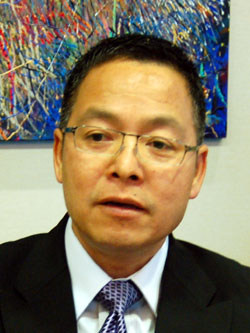
Time & date: 3 pm, 23 April 2015
Venue: Marina Mandarin Singapore
 Otto Marine's management at its AGM, L-R: Leon Yee (Legal Adviser, Duane Morris & Selvam LLP), Ng Quek Peng (Independent Director, Chairman for Audit Committee), Chong Sieh Jiuan (CFO), Michael See (Group CEO), Yaw Chee Siew (Executive Chairman), Garrick Stanley (President, Shipping and Chartering), Heng Hock Cheong (Lead Independent Director, Chairman for Nominating & Remuneration Committee), Craig Pickett (Non Executive Director), Chin Yoong Kheong (Independent Director). Photo by Sim Kih
Otto Marine's management at its AGM, L-R: Leon Yee (Legal Adviser, Duane Morris & Selvam LLP), Ng Quek Peng (Independent Director, Chairman for Audit Committee), Chong Sieh Jiuan (CFO), Michael See (Group CEO), Yaw Chee Siew (Executive Chairman), Garrick Stanley (President, Shipping and Chartering), Heng Hock Cheong (Lead Independent Director, Chairman for Nominating & Remuneration Committee), Craig Pickett (Non Executive Director), Chin Yoong Kheong (Independent Director). Photo by Sim Kih
AT OTTO MARINE'S AGM, its management assured shareholders that its fleet utilization is expected to improve in 2QFY2015 in spite of the slump in demand for offshore vessels caused by the recent plunge in oil prices.
The Group secured close to US$100 million worth of third party contracts during 1QFY2015.
Below is a summary of questions raised by shareholders, and the replies provided by Executive Chairman Yaw Chee Siew, Group CEO Michael See and the legal advisor Leon Yee.
 Executive Chairman Yaw Chee Siew. NextInsight file photo
Executive Chairman Yaw Chee Siew. NextInsight file photoMr Yaw: We have not had any vessel cancellation in FY2014 but like all other operators, we had some customers coming to us to renegotiate for a lower rate.
We have some short term contracts and some long term contracts.
The slump in oil prices provides an opportunity for us to focus on our efficiency and cost.
We are focusing on cost control and efficiency this year.
Q: Is Otto Marine capable of building lift boats?
Mr Yaw: At our shipyard, we focus on fabrication and ship repair. We also have some newbuilding projects for the local market in Indonesia.
We have not built any lift boats before and this is not an area we want to focus on. I personally believe that we have over the years built vessels that are more challenging to build than lift boats.
Having said that, if someone approaches us to build a lift boat and offers a price that makes the project profitable based on our cost estimates, I believe we can accept that order and execute a lift boat newbuilding project.
Q: In FY2014, Group revenue was about US$356 million and we had trade receivables of US$318 million. In FY2014, overdue trade receivables increased to about US$176 million (55% of receivables) when it was only 28% for FY2013. Why are receivables so high?
 Group CEO Michael See.
Group CEO Michael See.Photo: Company
US$67 million of the US$318 million is inter-company debt with associates within the Group.
Without reference to a specific case, here is how we account for inter-company debt using an example of the sale of a boat for US$90 million (at cost on arms-length basis) to our joint venture company.
We take a bank loan of US$60 million and the balance US$30 million is treated as receivables (instead of equity) until our associate company makes a profit and returns us the money.
Every month, the associate company pays us using the charter hire fees that it receives.
Another US$80 million of the US$318 million was deposited with leasing companies for sales and leaseback. We did that to improve the cashflow on our balance sheet.
The remaining receivables arise from joint ventures that we are unwinding. We will be collecting some of these receivables this year.
 President of Shipping & Chartering, Garrick Stanley. NextInsight file photo
President of Shipping & Chartering, Garrick Stanley. NextInsight file photoQ: Why was there a hike in management compensation between FY2013 and FY2014?
Mr See: Every year, our directors' and CEO's salaries total about S$2.2 million to S$2.3 million.
In 2014, total remuneration paid to directors increased to S$4.2 million because we gave share awards valued at S$1.8 million to Garrick Stanley during his tenure as Group CEO.
This is a talent retention bonus structured into our acquisition of Go Marine to align Mr Stanley’s interest with the Group's.
The share awards were part of the purchase consideration for the M&A.
Separately, the Group's senior management (including all directors, Mr Yaw, myself, and the CFO) took a pay cut of 20% effective from 1 March this year.
We are also proposing a 20% cut in fees payable to the independent directors.
 Crowd of shareholders at Otto Marine's AGM.
Crowd of shareholders at Otto Marine's AGM. Photo by Sim Kih
Q: Will you have a share consolidation?
Mr See: Under the new listing guideline, share consolidation is required for stocks trading at less than 20 cents.
The Board will make sure our share price is stable before setting the share consolidation date.
Q: Why don’t you move to Catalist to by-pass this share consolidation rule?
Many fund managers are not permitted to invest in Catalist companies.
It is in the interest of shareholders that we stay on the Main Board.







